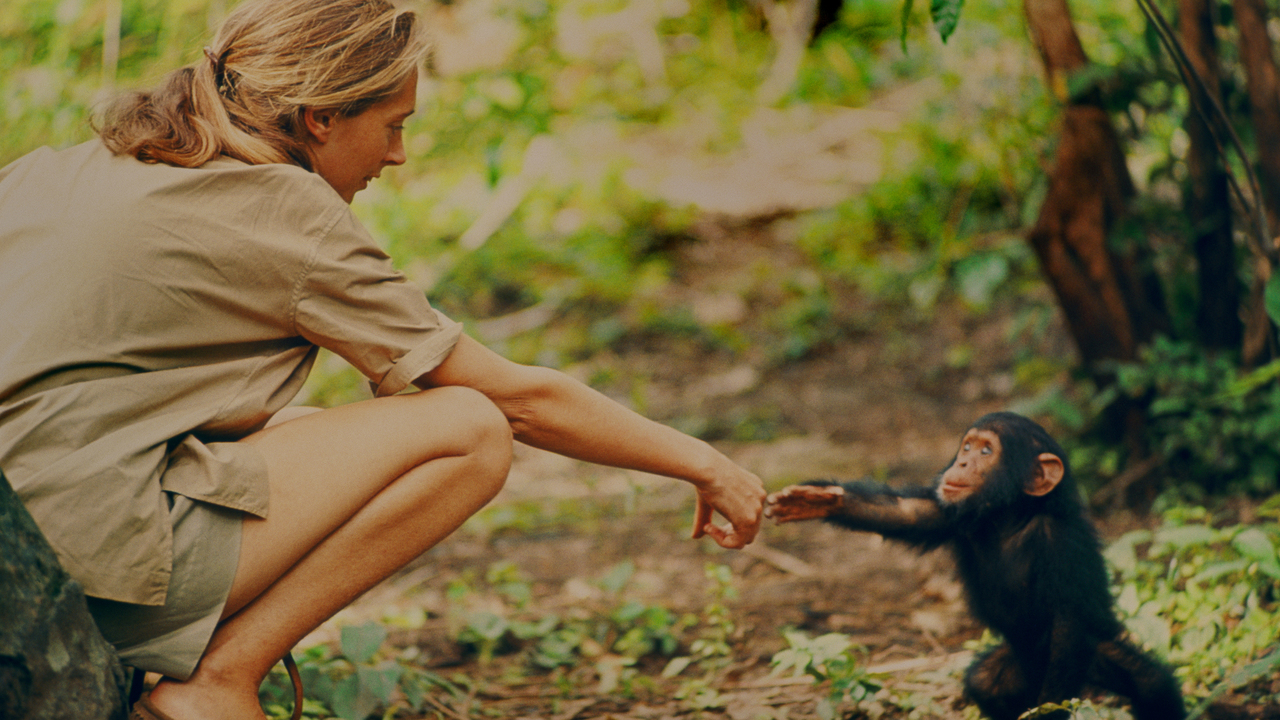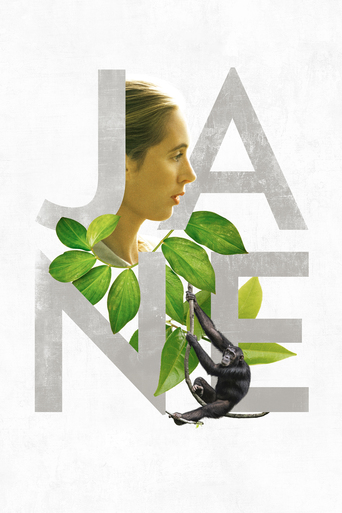

The greatest movie ever!
... View MoreLack of good storyline.
... View MoreIt was OK. I don't see why everyone loves it so much. It wasn't very smart or deep or well-directed.
... View MoreIt isn't all that great, actually. Really cheesy and very predicable of how certain scenes are gonna turn play out. However, I guess that's the charm of it all, because I would consider this one of my guilty pleasures.
... View MoreIt's always a nice feeling when you come out of a movie with a "Now that was GOOD!!"I remember Jane Goodall from those National Geographic documentaries and reading articles about her in the same magazine - years and years ago. But I never knew much about her. This film fills in those gaps - about who she is as an individual. And you learn about Chimpanzees too. I was surprised that she had absolutely no university training and background. She was a nature and animal lover - and brought a fresh perspective.The only quibble I have was that she states a few times that "she was on her own and alone". There were photographers with her and she had a base camp. Also the musical accompaniment was overdone.This is really a wonderful documentary on a now legendary and marvelous person.
... View MoreBritish Chimpanzee expert Jane Goodall is the subject of this American documentary which includes footage of her early research in Gombe, Tanzania in the 1950s and 1960s plus current interviews and narration made specifically for this film.The highest praise must go to the film footage preservationists who have maintained perfect prints of the colourful adventures in what was very high risk in unknown territory six decades ago. The superb footage is enhanced with Goodall's clear narration and a pleasurable score by Philip Glass.The first half is thrilling as it includes very surprising information of how Goodall was chosen for this mission especially regarding her background. The second half is still engaging but it has less novelty than the beginning. It still provides a lot of fascinating history though, including Goodall's personal life and the evolution of the chimp community with which she bonds.As the film evolves, it is easy to see that Goodall's patience must have been one of the reasons she was selected for the task. Even when the animals stay close to her, she knows to avoid touching them until the right moment.An unfulfilled curiosity is the lives and personalities of local Tanzanians who assist the mission. But the star attraction and the fabulous footage make this viewing worthwhile. What is most amazing is how Jane Goodall looks really very similar to how she did sixty years ago despite the inevitable effects of aging. Waiter, I'll have what she's having.
... View MoreIn 1960, primatologist Jane Goodall, the twenty six-year-old secretary of paleontologist Louis Leakey, was chosen to conduct research in Africa for his study of the influence of apes on primitive man. Though she was not a scientist and never attended university, her open mind, love of animals, and the strong support she received from her mother (who accompanied her to Africa) influenced his choice, one that turned out to be a very wise one. Reconstructed from over one hundred hours of footage shot by nature photographer Hugo van Lavick, Jane Goodall's life is brought to the screen in the riveting documentary simply called Jane. Directed by Brett Morgen("Cobain: Montage of Heck"), the film, which combines recent interviews with Jane, now 83, with the archival footage only discovered in 2014, transports us to the Gombe Stream National Park in Northwestern Tanzania, shortly before the country gained its independence from Britain in 1961. As narrated by Goodall from an audio recording of her 1999 book "Reason for Hope: A Spiritual Journey," we witness Jane's groundbreaking research into the behavior of chimpanzees in their natural environment, research that was initially questioned by the entrenched scientific community who said that her findings could not be taken seriously because she was a woman and lacked adequate training. The first person to observe chimpanzees in the wild, Jane was forced to keep her distance until the animals could accept the presence of the "white ape." Supported by the magnificent cinematography of Ellen Kraus and a moving score by Philip Glass, we see a silent Jane searching for observation points in the immaculate solitude of the mountains she grew to love. It was a process that required patience and fearlessness, which Jane tells us came from the fact that she did not know enough to be afraid. Her first important breakthrough occurred when she observed Greybeard, the oldest male chimp, using a twig tool to dig out termites from a brush. The discovery was contrary to the consensus opinion that only humans could use tools and was met with resistance, especially by religious groups. Though we now know that chimpanzees are among the most intelligent primates and that there is 99% identical DNA between human beings and chimpanzees, the media reported the story of Jane's accomplishments with the usual skepticism. Citing the fact that she gave the animals names instead of numbers, they asserted that it showed her tendency to anthropomorphize them and to over identify with the subjects she was researching. In spite of the critics, Jane received a grant from the National Geographic to continue her work and, though she was initially resistant to the idea, they also sent her a Dutch filmmaker, Hugo van Lavick, to record her work on film. Developing a relationship with Hugo, they eventually married and gave birth to a son they named Grub. It was Jane's observation of the bond between Flo, an older female, and her baby Flint that provided her with some lessons in child rearing, though the bond between Flo and Flint did not end happily. In one troubling incident, after the chimpanzees began to steal bananas from their tent, Jane and Hugo began to supply them to the chimps, hoping this would prevent a more aggressive intrusion. It was a decision that had to be rethought, however, when the animals invaded their tent and stole everything they could get their hands on. Even more distressing was an outbreak of polio among the community and the civil war that broke out between two factions of chimpanzees after the death of one of their maternal leaders, lending irony to Jane's assertion that, "The more I learned the more I realized how much like us they were." Unfortunately, Jane and Hugo began to drift apart when he lost the funding for his work in Gombe and left to photograph wild animals on the Serengeti Plain in Northern Tanzania, one of the natural wonders of the world. Now designated as an engendered species, chimpanzees have already disappeared from four African countries, and are nearing extinction in many others. Millions of chimpanzees used to live throughout equatorial Africa but today there are only 220,000 left in the world, a sad reminder of the increasing degradation of our planet. Thanks to The Jane Goodall Institute, an organization she founded that is dedicated to conservation, she has become an activist, traveling around the world talking about the need to protect endangered species, climate change, and the environment, attempting to build, in Werner Erhard's phrase, "a world that works for everyone."
... View MoreRelying heavily upon previously unseen footage from the film vaults of National Geographic, this release will be of interest to people who have followed Dr. Goodall's groundbreaking work. To the same audience, however, much of the narrative will already be familiar. To my mind, it is best seen as an appendix to the fine work that has already been done in documenting the now legendary story of Jane Goodall rather than as a definitive synopsis of her career. Given that much of the visuals are over half a century old, younger audiences especially might have difficulty reconciling the production values of mid-twentieth century field location footage with the high expectations engendered by the modern cinema experience. Where this film shines, and the reason I would encourage people to see this film in a cinema, is the sound. The score (by the inimitable and immediately recognizable Phillip Glass) is itself compelling, and appropriately mirrors the emotional cadence of the visual narrative. The sound design and editing, apart from the music, however, is truly brilliant. The theater erupts in a chorus of chimpanzee cries, among other jungle soundscapes, in many parts of the movie, and I almost felt the need to turn around to see what might be behind me at some points. Glass also cleverly weaves chimp calls into the score in a syncopated "cat's cradle" of rhythm at one point, which brought a smile on my face by mere virtue of its compositional ingenuity; this film is "ear candy." That being said, despite the many out of focus and grainy shots, there are some truly breathtaking visuals in the movie provided by Hugo van Lawick, Dr. Goodall's original videographer and eventual (ex)husband. The most breathtaking stuff comes from the Serengeti, and is therefore ancillary to Dr. Goodall's work the Gombe Reserve, but is still important in the personal narrative of her life. You will not see a more intimate portrayal of Dr. Goodall's journey elsewhere however, despite the miles of celluloid devoted to her. Anyone who reads her books will already be familiar with the story disclosed in the story line itself, including the incalculable value of the influence of Dr. Goodall's mother, but the footage of "Mum" in camp at Gombe will be a treat for those who have hitherto only known her as a character mentioned in prose, passing dialogue in a previous documentary, or mention in one of Dr. Goodall's innumerous public appearances. While much of the visual media of this film is novel, and the narrative itself mostly familiar, the presentation is likely to entertain, if not inform, almost any viewer. Modern audiences are cautioned to understand that this is not a film that relies upon computer- generated special effects, explosions, and a vast post-production budget beyond restoring and improving half- century old celluloid reels. It will very likely succeed in evoking an emotional response, which is, after all, the aim of any artistic work. That Dr. Goodall's entire career succeeds in the same vein is a powerful argument for the assertion that her life itself must be viewed as a contribution to art as much as to science.
... View More